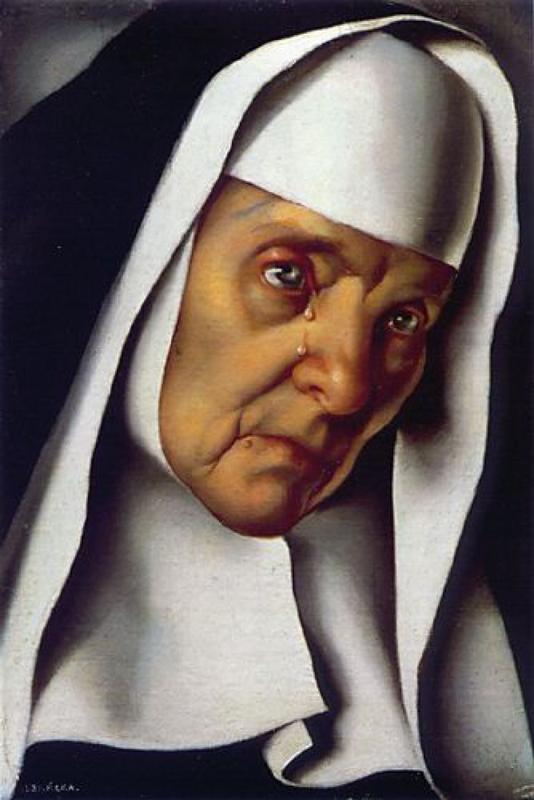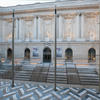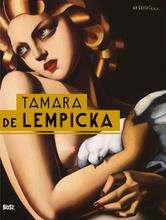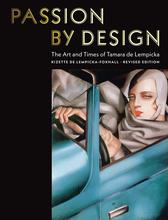More about Mother Superior
- All
- Info
- Shop

Contributor
Critics unanimously pan the Baroness de Lempicka's Mother Superior and her "glycerine tears."
This work is "rather maudlin" (British for "real cheesy"), says Andrew Graham-Dixon in a BBC documentary. There's no reason to think, based on a study of her biography and oeuvre, that de Lempicka intended blasphemy or satire, writes Patrick Bade, but "works such as the crying nun…pre-empt the self-consciously Kitsch" religious works of Pierre et Gilles (who, of course, deny that their work is "self-consciously Kitsch" in any way, insisting that their glittery, Pop-art style is "a way of being militant.")
Kitsch, like camp, can't be conscious of itself without becoming something else. You can, however, hold that de Lempicka's version of kitsch, self-conscious or not, is a strength of hers. You could also say that the critics are being unfair, hypocritical, and/or sexist in their condemnation of this work, and there can be a certain "mob mentality" when one critic throws some shade and everyone else dog-piles on an artist. It might seem that critics, as the official "taste makers," especially in 1935, when de Lempicka released this work, are like Orwell's "Big Brother," telling everyone else what to feel and think about art.
Nevertheless, no matter how finely you slice it, this work is a prime example of the Camp aesthetic, which Susan Sontag describes, in her era-shifting essay, as a "seriousness that fails." But it's hard to say why the Baroness fails here, while Camp from other artists, like Andy Warhol, tends to "succeed." It could be that, throughout the salacious years of the Factory, Warhol, living with his mom, remained a church-going Catholic, and so Warhol's relationship to Catholic iconography seems more sincere. According to Suzanne Tise-Isoré, de Lempicka painted this work following a spiritual retreat at a convent in Tuscany. In great detail, the Baroness told an interviewer how she rang the bell of a convent, looking for some higher purpose in the chaotic pre-war days following the stock market crash. She asked to see the mother superior and saw on the elder's face "the suffering of the world, so terrible to look at, so sad," and she "rushed out of the room," only to have the nun reappear to her later, in New York. "It was as if I was in a trance, a fever," the Baroness says.
Gilles Néret suggests that Mother Superior epitomizes de Lempicka's "more 'virtuous'" subjects, putting "scare quotes" around the word "virtuous," so as to emphasize the idea that the virtue which the Baroness attempts to express in this work is contrived or misguided, as when she awkwardly claimed, later in her career, that the poor are the "only pure" people in the world. Therefore, Néret continues, "is not Mother Superior found wanting" compared to the works that anticipate the flossin' look of late-90's Hype Williams hip hop videos, like Suzy Solidor and Beautiful Rafaela? The "honest faces of simple people" in de Lempicka's Old Men, The Breton Woman, and Young Dutch Girl, Néret adds, are weak next to the "Ingresesque lasciviousness" of her impressive nudes, Andromeda, and Rhythm. Suffice to say, critics did not dig this painting, which the artist donated to the Musée d'arts de Nantes in 1976, when she was in her late seventies.
Sources
- Aldrich, Robert, and Garry Wotherspoon. Who's who in Contemporary Gay and Lesbian History: From World War II to the Present Day. London: Routledge, 2001.
- Bade, Patrick. Lempicka. New York: Parkstone International, 2012.
- Dillenberger, Jane D. The Religious Art of Andy Warhol. New York: Continuum, 1998.
- Graham-Dixon, Andrew. "Tamara de Lempicka, Worldly Deco Diva…" YouTube video, 2004. 28:56, https://youtu.be/kiWKU0oo2t0.
- de Lempicka-Foxhall, the Baroness Kizette, and Charles Phillips. Passion by Design: The Art and Times of Tamara de Lempicka. London: Phaidon, 1989.
- "Mère supérieure." Navigart, https://www.navigart.fr/museedartsdenantes/#/artwork/110000000002437?la….
- Tise-Isoré, Suzanne. Lempicka. Paris: Flammarion, 2006.













